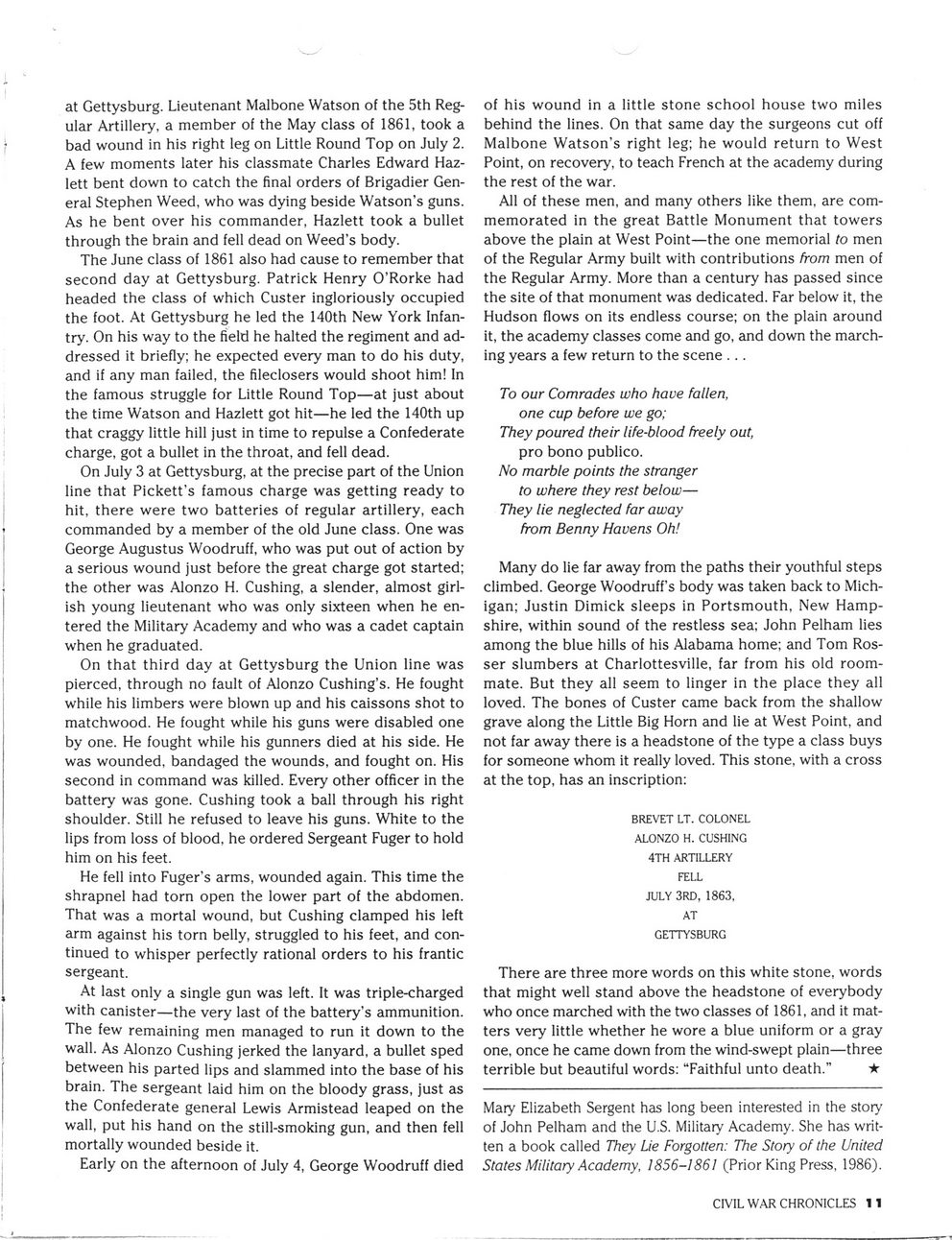This text was obtained via automated optical character recognition.
It has not been edited and may therefore contain several errors.
at Gettysburg. Lieutenant Malbone Watson of the 5th Regular Artillery, a member of the May class of 1861, took a bad wound in his right leg on Little Round Top on July 2. A few moments later his classmate Charles Edward Haz-lett bent down to catch the final orders of Brigadier General Stephen Weed, who was dying beside Watson?s guns. As he bent over his commander, Hazlett took a bullet through the brain and fell dead on Weed?s body. The June class of 1861 also had cause to remember that second day at Gettysburg. Patrick Henry O?Rorke had headed the class of which Custer ingloriously occupied the foot. At Gettysburg he led the 140th New York Infantry. On his way to the field he halted the regiment and addressed it briefly; he expected every man to do his duty, and if any man failed, the fileclosers would shoot him! In the famous struggle for Little Round Top?at just about the time Watson and Hazlett got hit?he led the 140th up that craggy little hill just in time to repulse a Confederate charge, got a bullet in the throat, and fell dead. On July 3 at Gettysburg, at the precise part of the Union line that Pickett?s famous charge was getting ready to hit, there were two batteries of regular artillery, each commanded by a member of the old June class. One was George Augustus Woodruff, who was put out of action by a serious wound just before the great charge got started; the other was Alonzo H. Cushing, a slender, almost girlish young lieutenant who was only sixteen when he entered the Military Academy and who was a cadet captain when he graduated. On that third day at Gettysburg the Union line was pierced, through no fault of Alonzo Cushing?s. He fought while his limbers were blown up and his caissons shot to matchwood. He fought while his guns were disabled one by one. He fought while his gunners died at his side. He was wounded, bandaged the wounds, and fought on. His second in command was killed. Every other officer in the battery was gone. Cushing took a ball through his right shoulder. Still he refused to leave his guns. White to the lips from loss of blood, he ordered Sergeant Fuger to hold him on his feet. He fell into Fuger?s arms, wounded again. This time the shrapnel had torn open the lower part of the abdomen. That was a mortal wound, but Cushing clamped his left arm against his torn belly, struggled to his feet, and continued to whisper perfectly rational orders to his frantic sergeant. At last only a single gun was left. It was triple-charged with canister?the very last of the battery?s ammunition. The few remaining men managed to run it down to the wall. As Alonzo Cushing jerked the lanyard, a bullet sped between his parted lips and slammed into the base of his brain. The sergeant laid him on the bloody grass, just as the Confederate general Lewis Armistead leaped on the wall, put his hand on the still-smoking gun, and then fell mortally wounded beside it. Early on the afternoon of July 4, George Woodruff died of his wound in a little stone school house two miles behind the lines. On that same day the surgeons cut off Malbone Watson?s right leg; he would return to West Point, on recovery, to teach French at the academy during the rest of the war. All of these men, and many others like them, are commemorated in the great Battle Monument that towers above the plain at West Point?the one memorial to men of the Regular Army built with contributions from men of the Regular Army. More than a century has passed since the site of that monument was dedicated. Far below it, the Hudson flows on its endless course; on the plain around it, the academy classes come and go, and down the marching years a few return to the scene ... To our Comrades who have fallen, one cup before we go; They poured their life-blood freely out, pro bono publico. No marble points the stranger to where they rest below? They lie neglected far away from Benny Havens Oh! Many do lie far away from the paths their youthful steps climbed. George Woodruffs body was taken back to Michigan; Justin Dimick sleeps in Portsmouth, New Hampshire, within sound of the restless sea; John Pelham lies among the blue hills of his Alabama home; and Tom Rosser slumbers at Charlottesville, far from his old roommate. But they all seem to linger in the place they all loved. The bones of Custer came back from the shallow grave along the Little Big Horn and lie at West Point, and not far away there is a headstone of the type a class buys for someone whom it really loved. This stone, with a cross at the top, has an inscription: BREVET LT. COLONEL ALONZO H. CUSHING 4TH ARTILLERY FELL JULY 3RD, 1863, AT GETTYSBURG There are three more words on this white stone, words that might well stand above the headstone of everybody who once marched with the two classes of 1861, and it matters very little whether he wore a blue uniform or a gray one, once he came down from the wind-swept plain?three terrible but beautiful words: ?Faithful unto death.? ? Mary Elizabeth Sergent has long been interested in the story of John Pelham and the U.S. Military Academy. She has written a book called They Lie Forgotten: The Story of the United States Military Academy, 1856-1861 (Prior King Press, 1986). CIVIL WAR CHRONICLES 11

Ames, Adelbert Civil-War-Chronicles-page11